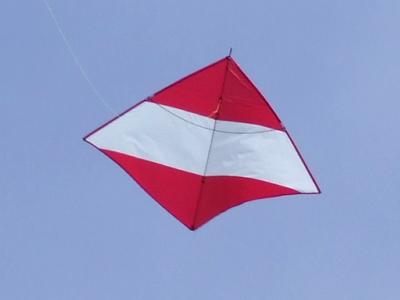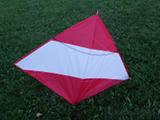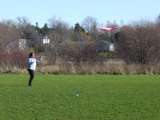
Urban Ninja

Detailed plans and building instructions are provided by the designer, right here at horvath.ch .
This is a wonderful design for low-wind/no-wind conditions. Properly speaking though, mine isn't a purebred Urban Ninja, because I departed from the plans a bit.
It is made with three seperate panels (even if it is to be all one colour) because of the curve in the spine seam. The seams do not follow a straight line across the middle, but form shallow "V"s. You end up with a slight dish and a dihedral in the assembled skin.
The frame is made from 3.2 mm carbon fibre tubes, including the spreader.
When it's flown as a zero-wind glider, it is spooky the way it seems to just hang there in the air like a balloon. If you turn it facing into a very slight breeze it can appear to be almost motionless. There are a couple of videos on Youtube (not mine) that show them in flight.
 - Balanced on one trailing edge, ready to launch.
- Balanced on one trailing edge, ready to launch.
 - Here's Sue trying it out for the first time. (400 x 300 version)
- Here's Sue trying it out for the first time. (400 x 300 version)
I like to fly it on 20-pound test Streamside Dacron fly line backing, on a 6-inch slanted hoop winder. (Note - that product is mislabeled as "Darcon". It's a typo.) It's fairly soft and easy to handle, and I like the fluorescent yellow-green colour. It comes on 100-yard spools. I need the bright colour because I usually have 20-50 feet of it laying on the ground and it's easy to see where it is and how much is out at a glance.
The nose weights
The spine is always curved a bit, following the centre seam, even with minimum tension on the "Y" line. When it glides forward, it tends to pull the nose up, and it stalls. To keep the nose down, I modified five hexagonal "stove bolt" nuts by drilling out the threads to 1/4", to use as ballast, or nose weights. Each nut weighs 3 grams, and placing 3 or 4 of them at the front end of the spine keeps the kite from pitching up and helps it to go into long soaring glides. There's a short piece of poly tubing near the nose end of the spine to keep the weights from sliding back along the spine.
My setup for zero-wind gliding
I adjust the "Y" line for minimum tension, which give a fairly flat dihedral and a bit tighter skin. I usually add 4 of the nose weights, for a total of 12 grams. Sometimes I only use 3 of them, for 9 grams.
My setup for static flying
If the wind is consistently stronger than, say, 2 or 3 kilometers per hour, I just fly it like a regular single-line kite. I remove the nose weights, and shorten the "Y" line such that it's about one hand-width off the spine. This additional tension of the "Y" line on the "X" line also pulls the wing spars in a bit, and the sail goes quite slack. It is then less likely to loop in stronger winds.